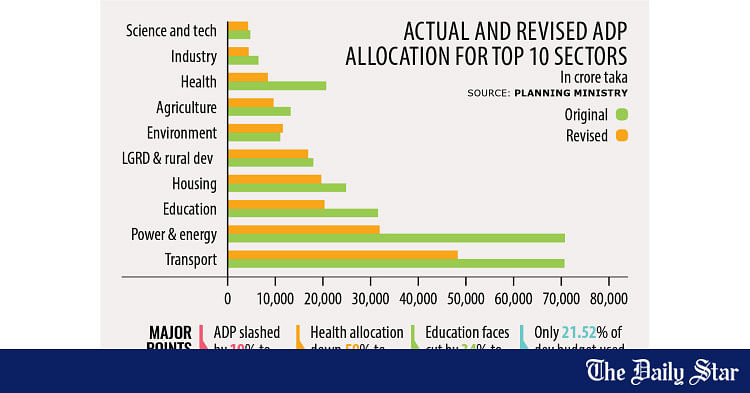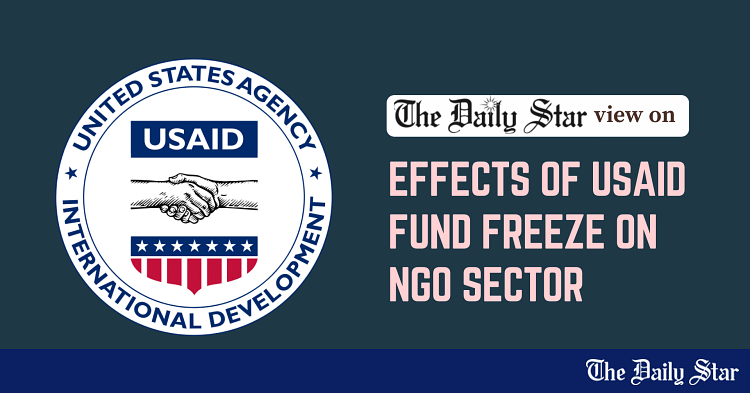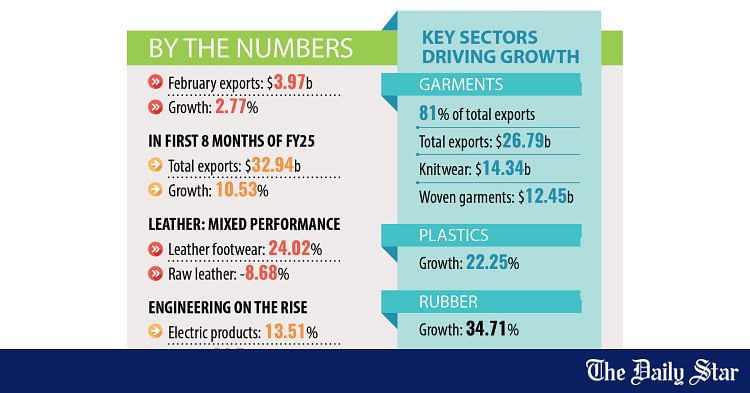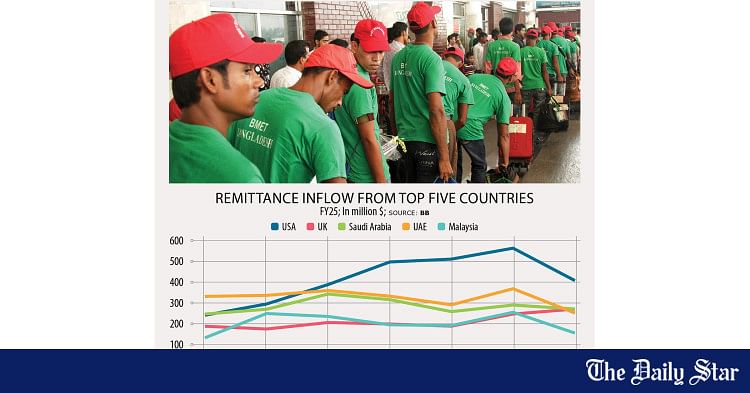Saif
Senior Member
- Jan 24, 2024
- 12,725
- 7,062
- Origin

- Residence

- Axis Group

- Copy to clipboard
- Thread starter
- #565

Deep cut to dev spending
The interim government yesterday approved a Tk 226,125 crore revised Annual Development Programme (ADP), while the health sector saw more than a 50 percent reduction in its original allocation despite being a priority sector.
Deep cut to dev spending
Allocation trimmed by 19% to Tk 2.26 lakh crore

The interim government yesterday approved a Tk 226,125 crore revised Annual Development Programme (ADP), while the health sector saw more than a 50 percent reduction in its original allocation despite being a priority sector.
The decision was made at a National Economic Council (NEC) meeting at its premises in the capital, with NEC Chairperson and Chief Adviser Prof Muhammad Yunus presiding.
The size of the revised ADP was reduced by 19 percent, from the original Tk 278,289 crore.
Although the health sector was among the top ten highest recipients in the original allocation, it has now faced a 59 percent cut, with its allocation slashed to Tk 8,463 crore.
Acknowledging the lower allocation in the revised ADP for health, Planning Adviser Wahiduddin Mahmud said the implementation rate of the sector was not satisfactory.
"In many areas, infrastructure and equipment remain abandoned due to a shortage of doctors, nurses and technicians," said the adviser.
"Doctors and nurses should be appointed in the health sector on a priority basis, rather than focusing solely on building infrastructure," he said.
"There are many vacant posts, and usually, doctors are reluctant to work in rural areas. This is a matter of governance," he said.
Like the health sector, the education sector saw a 34 percent cut, bringing its allocation down to Tk 20,349 crore.
Regarding this sector, Prof Mahmud noted that the performance of secondary and higher education had also remained poor.
He pointed out that several universities had set up campuses in various districts, but the number of staff recruited were more that of students and teachers.
Many of these staff members were hired based on political affiliations, he further said.
"Before increasing allocations, we must sort out these kinds of anomalies," he added.
In the revised ADP, the number of projects with allocations increased to 1,434 from 1,326 in the original ADP.
The interim government took office in August last year after a student-led mass uprising ousted the Awami League government, which formulated the FY25 budget in June.
A planning ministry official said the pace of project implementation had been slow this fiscal year because of the political turmoil.
In the first seven months of the ongoing fiscal year, only 21.52 percent of the ADP was spent, 5.59 percent less than the expenditures made during the same period last fiscal year, said the official.
Usually, when the finance and planning ministries seek demands from various ministries, they tend to request higher allocations than granted.
However, this time, the ministries demanded less than Tk 200,000 crore in total, lower than the original ADP.
According to the planning ministry official, of the 57 ministries and divisions, eight saw an increase of 0.81 percent in their revised ADP allocations, while the allocation for 48 ministries and divisions decreased by 26 percent. The rest remained unchanged.
The revised ADP allocated around 47 percent of total funds to the transport and communications, power and energy, and education sectors.
In the revised ADP, the government budget was reduced by Tk 49,000 crore to Tk 216,000 crore.
Of this, government funds were reduced by 18.18 percent to Tk 135,000 crore, while foreign funds fell by 19 percent to Tk 81,000 crore.
Besides, the ADP for state-owned enterprises was reduced by Tk 10,125 crore, from the original Tk 13,288 crore.
Among the top recipients in terms of allocation, transport and communications will receive Tk 48,253 crore (22.34 percent), power and energy Tk 31,898 crore (14.77 percent), housing and community services Tk 19,653 crore (9 percent), and local government and rural development Tk 16,909 crore (7.82 percent), according to a planning ministry official.
In terms of allocation for ministries and divisions, the Local Government and Rural Development Ministry will receive the highest allocation of Tk 36,159 crore (17 percent).
Of the total 1,434 projects with allocations in the revised ADP, 1,326 have been carried over from the original ADP as ongoing projects.
Additionally, 97 new projects have been included in the revised ADP, which were listed as unapproved in the original ADP.
Moreover, the interim government included 11 new projects in the revised ADP, which were not listed in the original ADP.
Also, in the revised ADP, 770 projects have been listed as unapproved projects without allocation.
Allocation trimmed by 19% to Tk 2.26 lakh crore
The interim government yesterday approved a Tk 226,125 crore revised Annual Development Programme (ADP), while the health sector saw more than a 50 percent reduction in its original allocation despite being a priority sector.
The decision was made at a National Economic Council (NEC) meeting at its premises in the capital, with NEC Chairperson and Chief Adviser Prof Muhammad Yunus presiding.
The size of the revised ADP was reduced by 19 percent, from the original Tk 278,289 crore.
Although the health sector was among the top ten highest recipients in the original allocation, it has now faced a 59 percent cut, with its allocation slashed to Tk 8,463 crore.
Acknowledging the lower allocation in the revised ADP for health, Planning Adviser Wahiduddin Mahmud said the implementation rate of the sector was not satisfactory.
"In many areas, infrastructure and equipment remain abandoned due to a shortage of doctors, nurses and technicians," said the adviser.
"Doctors and nurses should be appointed in the health sector on a priority basis, rather than focusing solely on building infrastructure," he said.
"There are many vacant posts, and usually, doctors are reluctant to work in rural areas. This is a matter of governance," he said.
Like the health sector, the education sector saw a 34 percent cut, bringing its allocation down to Tk 20,349 crore.
Regarding this sector, Prof Mahmud noted that the performance of secondary and higher education had also remained poor.
He pointed out that several universities had set up campuses in various districts, but the number of staff recruited were more that of students and teachers.
Many of these staff members were hired based on political affiliations, he further said.
"Before increasing allocations, we must sort out these kinds of anomalies," he added.
In the revised ADP, the number of projects with allocations increased to 1,434 from 1,326 in the original ADP.
The interim government took office in August last year after a student-led mass uprising ousted the Awami League government, which formulated the FY25 budget in June.
A planning ministry official said the pace of project implementation had been slow this fiscal year because of the political turmoil.
In the first seven months of the ongoing fiscal year, only 21.52 percent of the ADP was spent, 5.59 percent less than the expenditures made during the same period last fiscal year, said the official.
Usually, when the finance and planning ministries seek demands from various ministries, they tend to request higher allocations than granted.
However, this time, the ministries demanded less than Tk 200,000 crore in total, lower than the original ADP.
According to the planning ministry official, of the 57 ministries and divisions, eight saw an increase of 0.81 percent in their revised ADP allocations, while the allocation for 48 ministries and divisions decreased by 26 percent. The rest remained unchanged.
The revised ADP allocated around 47 percent of total funds to the transport and communications, power and energy, and education sectors.
In the revised ADP, the government budget was reduced by Tk 49,000 crore to Tk 216,000 crore.
Of this, government funds were reduced by 18.18 percent to Tk 135,000 crore, while foreign funds fell by 19 percent to Tk 81,000 crore.
Besides, the ADP for state-owned enterprises was reduced by Tk 10,125 crore, from the original Tk 13,288 crore.
Among the top recipients in terms of allocation, transport and communications will receive Tk 48,253 crore (22.34 percent), power and energy Tk 31,898 crore (14.77 percent), housing and community services Tk 19,653 crore (9 percent), and local government and rural development Tk 16,909 crore (7.82 percent), according to a planning ministry official.
In terms of allocation for ministries and divisions, the Local Government and Rural Development Ministry will receive the highest allocation of Tk 36,159 crore (17 percent).
Of the total 1,434 projects with allocations in the revised ADP, 1,326 have been carried over from the original ADP as ongoing projects.
Additionally, 97 new projects have been included in the revised ADP, which were listed as unapproved in the original ADP.
Moreover, the interim government included 11 new projects in the revised ADP, which were not listed in the original ADP.
Also, in the revised ADP, 770 projects have been listed as unapproved projects without allocation.












